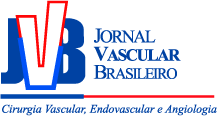Endotelium in Turner syndrome with capillaroscopy
Endotélio na síndrome de Turner com capilaroscopia
Simone Cristina da Silva Coelho; Marília Martins Guimarães; Terezinha Jesus Fernandes
Abstract
Keywords
Resumo
Palavras-chave
References
Bondy, CA. Care of girls and women with Turner Syndrome: a guidline of Turner Syndrome Study Group. J Clin Endocrinol Metab.. 2007;92:10-25.
Stochholm K, Juul S, Juel K, Naeraa RW, Gravholt CH. Prevalence, incidence, diagnostic delay, and mortality in Turner Syndrome. J Clin Endocrinol Metab.. 2006;91:3897-902.
Bondy CA. Turner syndrome 2008. Horm Res.. 2009;71:52-6.
Dulac Y, Pienkowski C, Abadir S, Tauber M, Acar P. Cardiovascular abnormalities in Turner's syndrome: what prevention?. Arch Cardiovasc Dis.. 2008;101:485-90.
Gravholt CH. Epidemiological, endocrine and metabolic features in Turner syndrome. Eur J Endocrinol.. 2004;151:657-87.
Bakalov VK, Cooley MM, Quon MJ. Impaired insulin secretion in the Turner metabolic syndrome. J Clin Endcrinol Metab.. 2004;89:3516-20.
Alves STF, Gallichio CT, Guimarães MM. Insulin resistance and body composition in Turner syndrome: Effect of sequential change in the route of estrogen administration. Gynecol Endocrinol.. 2006;22:590-4.
Gravholt CH. Epidemiology of Turner syndrome. Lancet Oncol.. 2008;9:193-5.
Ho VB, Bakalov VK, Cooley M. Major vascular anomalies in Turner Syndrome: prevalence and magnetic resonance angiographic features. Circulation.. 2004;110:1694-700.
Bannink EM, van der Palen RL, Mulder PG, de Muinck Keizer-Schrama SM. Long-term follow-up of GH-treated girls with Turner syndrome: metabolic consequences. Horm Res.. 2009;71:343-9.
Tooke JE, Hannemann MM. Adverse endothelial function and the insulin resistance syndrome. J Intern Med.. 2000;247:425-31.
Gravholt CH, Nyholm B, Saltin B, Schmitz O, Christiansen JS. Muscle fiber composition and capillary density in Turner syndrome: evidence of increased muscle fiber size related to insulin resistance. Diabetes Care.. 2001;24:1668-73.
Halfoun VLRC, Fernandes TJ, Pires MLE, Braun E, Cardozo MGT, Bahbout GC. Estudos morfológicos e funcionais da microcirculação da pele no diabetes mellitus. Arq Bras Endocrinol Metab.. 2003;47:271-9.
Gallucci F, Russo R, Buono R, Acampora R, Madrid E, Uomo G. Indications and results of videocapillaroscopy in clinical practice. Adv Med Sci.. 2008;53:149-57.
Lambora SN, Müller-Ladner U. The specificity of capillaroscopic pattern in connective autoimunne diseases. A comparison with microvascular changes in diseases of social importance: arterial hypertension and diabetes mellitus. Mod Rheumatol.. 2009;19:600-5.
Meyer MF, Rose CJ, Schartz H, Klein HH. Effects of a short-term improvement in glycaemic control on skin microvascular dysfunction in Type 1 and Type 2 diabetic patients. Diabet Med.. 2009;26:880-6.
Lu Q, Freyschuss A, Jonsson AM, Björkhem I, Henriksson P. Post-occlusive reactive hyperemia in single nutritive capillaries of the nail fold: methodological considerations. Scand J Clin Lab Invest.. 2002;62:537-9.
Tooke JE. Endothelium: the main actor or choreographer in remodelling of the retinal microvasculature in diabetes?. Diabetologia.. 1996;39:745-6.
Golster H, Hyllienmark L, Ledin T, Ludvigsson J, Sjöberg F. Impaired microvascular function related to poor metabolic control in young patients with diabetes. Clin Physiol Funct Imaging.. 2005;25:100-5.
Coelho SCS, Ramos AD, Pinheiro VS. Nailfold video capillaroscopy in Turner syndrome: a descriptive study. J Vasc Bras.. 2007;6:325-31.
Meyer MF, Pfohl M, Schatz H. Assessment of diabetic alterations of microcirculation by means of capillaroscopy and laser-Doppler anemometry. Med Klin (Munich).. 2001;96:71-7.
Halfoun VLRC, Pires MLE, Fernandes TJ, Victer F, Rodrigues KK, Tavares R. Videocapillaroscopy and Diabetes mellitus: area of transverse segment in nailfold capillar loops reflects vascular reactiviy. Diabetes Res Clin Pract.. 2003;61:155-60.
Chang CH, Tsai RK, Wu WC, Kuo SL, Yu HS. Use of dynamic capillaroscopy for studying cutaneous microcirculation in patients with diabetes mellitus. Microvasc Res.. 1997;53:121-7.
Tooke JE, Ostergren J, Lins PE, Fagrell B. Skin microvascular blood flow control in long duration diabetics with and without complication. Diabetes Res.. 1987;5:189-92.
Fredriksson I, Larsson M, Nyströn FH, Länne T, Ostgren CJ, Strömberg T. Reduced arteriovenous shunting capacity after local heating and redistribution of baseline skin blood flow in type 2 diabetes assessed with velocity-resolved quantitative laser Doppler flowmetry. Diabetes.. 2010;59:1578-84.

